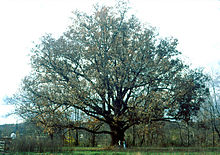Quercus alba
| White oak | |
|---|---|
 |
|
| A large white oak growing in Ohio | |
| Scientific classification | |
| Kingdom: | Plantae |
| (unranked): | Angiosperms |
| (unranked): | Eudicots |
| (unranked): | Rosids |
| Order: | Fagales |
| Family: | Fagaceae |
| Genus: | Quercus |
| Section: | Quercus |
| Species: | Q. alba |
| Binomial name | |
|
Quercus alba L. 1753 |
|
 |
|
| Natural range | |
| Synonyms | |
|
List
|
|
Quercus alba, the white oak, is one of the preeminent hardwoods of eastern and central North America. It is a long-lived oak, native to eastern and central North America and found from Minnesota, Ontario, Quebec, and Nova Scotia south as far as northern Florida and eastern Texas. Specimens have been documented to be over 450 years old.
Although called a white oak, it is very unusual to find an individual specimen with white bark; the usual color is a light gray. In the forest it can reach a magnificent height and in the open it develops into a massive broad-topped tree with large branches striking out at wide angles.
Q. alba typically reaches heights of 80 to 100 feet (24–30 m) at maturity, and its canopy can become quite massive as its lower branches are apt to extend far out laterally, parallel to the ground. Trees growing in a forest will become much taller than ones in an open area which develop to be short and massive. The tallest known white oak is 144 feet (44 m) tall. It is not unusual for a white oak tree to be as wide as it is tall, but specimens growing at high altitudes may only become small shrubs.
White oak may live 200 to 300 years, with some even older specimens known. The Wye Oak in Wye Mills, Maryland was estimated to be over 450 years old when it finally fell in a thunderstorm in 2002.
Another noted white oak is the Great White Oak in Basking Ridge, New Jersey, estimated to be over 600 years old. The tree measures 25 feet (7.6 m) in circumference at the base and 16 feet (4.9 m) in circumference four feet (1.2 m) above the ground. The tree is 75 feet (23 m) tall, and its branches spread over 125 feet (38 m) from tip to tip. The oak, claimed to be the oldest in the United States, began showing signs of poor health in the mid-2010s. The tree was declared dead in 2016 and was planned to be taken down in 2017.
Sexual maturity begins at around 20 years, but the tree does not produce large crops of acorns until its 50th year and the amount varies from year to year. Acorns deteriorate quickly after ripening, the germination rate being only 10% for six-month-old seeds. As the acorns are prime food for animals and insects, all may be lost in years of small crops.
...
Wikipedia

